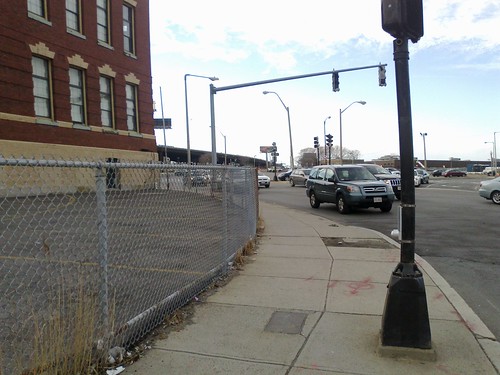I often hear traffic engineers and other people talking about "queuing" in lanes lead up to intersections (for example, near
the River Street bridge). It seems to them to be very important to have enough space for vehicles to wait as they transfer between roads. From my computer science perspective, I understand where they are coming from; I have a working familiarity with
queueing theory and I am wary of deadlocks. But there is a significant difference between abstract mathematical notion of queues and the reality of human-driven automobile traffic on roads. The flows between roads aren't immutable, and there are a lot of subtle feedback effects which drive patterns of congestion: the very kind of behaviors which are not handled well by queueing theory.
 |
| Rose Kennedy Greenway |
If I had magical powers, I would wave a wand and make congestion problems disappear for everyone (well, after curing cancer, etc). In reality, when people talk about relieving congestion, they generally mean "add a lane." Perhaps the one lane can only hold 25 vehicles while waiting at a light, and observations have shown that there are 30 vehicles waiting at worst during peak hours -- spilling and blocking the roadway behind them. So the natural suggestion is to add a lane and accommodate up to 50 vehicles. The problem is that with all this extra capacity, more people will make the decision to use the newly widened road for their trips. Also, clearing up the blocked traffic on the feeding road gives more vehicles the opportunity to make the turn. As a result, the newly widened roads ends up overflowing with 55 vehicles instead of 30. It's just another case of '
the fundamental law of highway congestion' which, in econ-speak says: elasticity of vehicle kilometers traveled to lane kilometers is close to 1. In normal person-speak, that means that car traffic almost always
fills up available road space (see also:
Downs-Thomson paradox).
 |
| Near Sullivan Square |
Now if adding a lane actually worked, had low costs and little other impact, there would be hardly much more to say about this. But without a magic wand, that is not the case. Expanding roadways in urban neighborhoods causes direct harm to the inhabitants of that area. It is more difficult to walk across wider roadways, it is more dangerous to be around them, and there is more pollution from the added vehicles. So by choosing to widen a road, it is likely that you have failed to solve the congestion problem, and you've made life worse for residents and other people in the area.



No comments:
Post a Comment
Note: Only a member of this blog may post a comment.